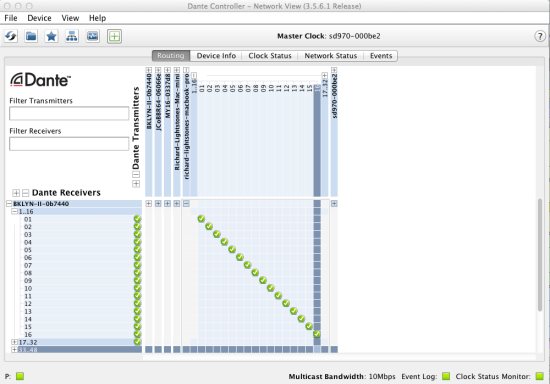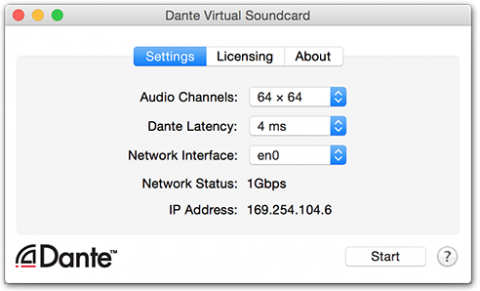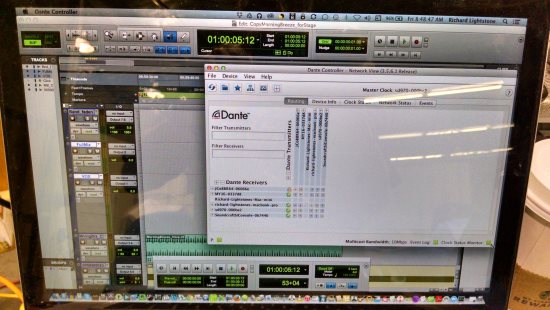DANTE. It’s a networking protocol and it is quickly being integrated into many Production Sound Mixers’ workflow. Full disclosure, I am a Dante user, which I had to license by purchasing a Dante-enabled product.

Dante is owned by Audinate, an Australian company, the seeds of which were sown by some former employees of the Motorola Research Labs, shuttered in 2003. Co-founder and Chief Technology Officer Aidan Williams explains. “I was constantly connecting my synth to a mixer, to a sound card, MIDI cables, all sorts of different connections,” he recalls. “To me, it seemed like a networking problem. Why make all those different connections when you could integrate it into a single network?” In 2006, David Myers joined Williams to form Audinate
Bruce Jackson, Vice President of Dolby Labs’ Live Division, an early advocate, made the Dolby Lake Processor the first Dante-equipped professional audio device to be used at a performance of Barbra Streisand in Washington, D.C., in 2008. That same year, Lee Elison joined the company, opening its US headquarters in Portland, Oregon.
Dante has played a role in numerous mission-critical events; from the 2010 Winter Olympics in Vancouver, the Pope’s appearance at World Youth Day in Sydney, to hundreds of concerts by major music performers. There are more than 170 manufacturers who have partnered with Audinate, representing more than five hundred different products that are Dante-enabled.

How Dante works?
In its simplest form, Dante is a protocol for communicating multiple audio channels over standard Ethernet and IP networks. Audio signals between Dante-enabled devices are routed using Dante Controller software. In the analog world, audio connections are point-to-point and individual copper cables representing each channel. In Dante, the physical connecting point is irrelevant as long as all the devices are connected to the same network, audio signals can be made available anywhere and everywhere. Patching and routing are configured in software and not over physical wired links. Depending on the application, Dante allows up to 512 bidirectional channels of audio to be sent and distributed over an Ethernet network, using CAT-5e or CAT-6 cable.

Dante was built to work on Gigabit Ethernet, so it already rides a fat pipe. Those 512 bidirectional channels can be sent on a 1Gb link, uncompressed, 48kHz, 24-bit audio. Latency can be as low as .25mS. One link can simultaneously carry audio with different sample rates and bit depths. You can also set up a system with multiple network zones, each with a different latency to match the needs of your equipment.
There are other AOE (Audio Over Ethernet) protocols available. The most popular are:
CobraNet
Peak Audio developed CobraNet in 1996. It accommodates up to sixty-four bidirectional channels of audio over a single CAT-5 or fiber-optic cable. You aren’t going to get advanced features like self-configuration, bandwidth adaptation or error correction. Since it’s a digital signal, equipment does have the ability to process the audio, but that’s a function of the manufacturer’s gear, not CobraNet itself.
MADI
MADI (Multichannel Audio Digital Interface) was an AES standard protocol, developed in 1991 and further improved by AMS Neve, Solid State Logic, Sony and Mitsubishi. It is a unidirectional (point-to-point) approach that allows up to sixty-four audio channels over coaxial or fiber-optic cables and less commonly CAT-5 from a few manufacturers.
How to use Dante?
Simply purchase a mixing console and recorder that has Audinate Dante available. Consoles such as the Yamaha 01V96 and 01V96i have a single-card slot to accommodate a Dante card. There are many other consoles that do the same; Behringer, Allen & Heath and the Soundcraft Expressions and Performer series to name a few. Many manufacturers have Dante built in like the Yamaha QL-1, the Sound Devices PIX 260i, the 970 and the Cantar X3.
Dante devices have a primary and secondary port for redundancy, meaning, there are two identical but separate networks providing a failsafe if one of the networks fails. You can disable Dante Redundancy Mode and use the second port to connect to another Dante-enabled device.
Daisy-chaining Dante devices can be done, with caution, but it is recommended to use a Gigabit Switch in a “star” topology to connect to multiple Dante devices.

Gigabit Switches
Gigabit Switches are just that, multi-port switches that can handle high-speed audio traffic with excellent management, often called QoS or Quality of Service. Some of us are using simple 5-port switches, such as the Netgear GS105, which retails for around $40 and can be powered via 12 volts. Others prefer the Cisco brand, starting with eight ports and up. Whatever you purchase, make sure they are not EEE (Energy Efficient Ethernet), also known as Green Ethernet. These units will reduce power to individual switches during periods of low network traffic, resulting in poor synchronization and even signal dropouts!
Dante Controller will also work with other DAW software like Boom Recorder, Pro Tools (9 and up), Logic and Cubase up to sixty-four channels. This is achieved via Dante Virtual Soundcard software.
Dante networks are not restricted to digital consoles and peripherals. You can connect analog equipment to Dante interface boxes that do the A to D conversion.